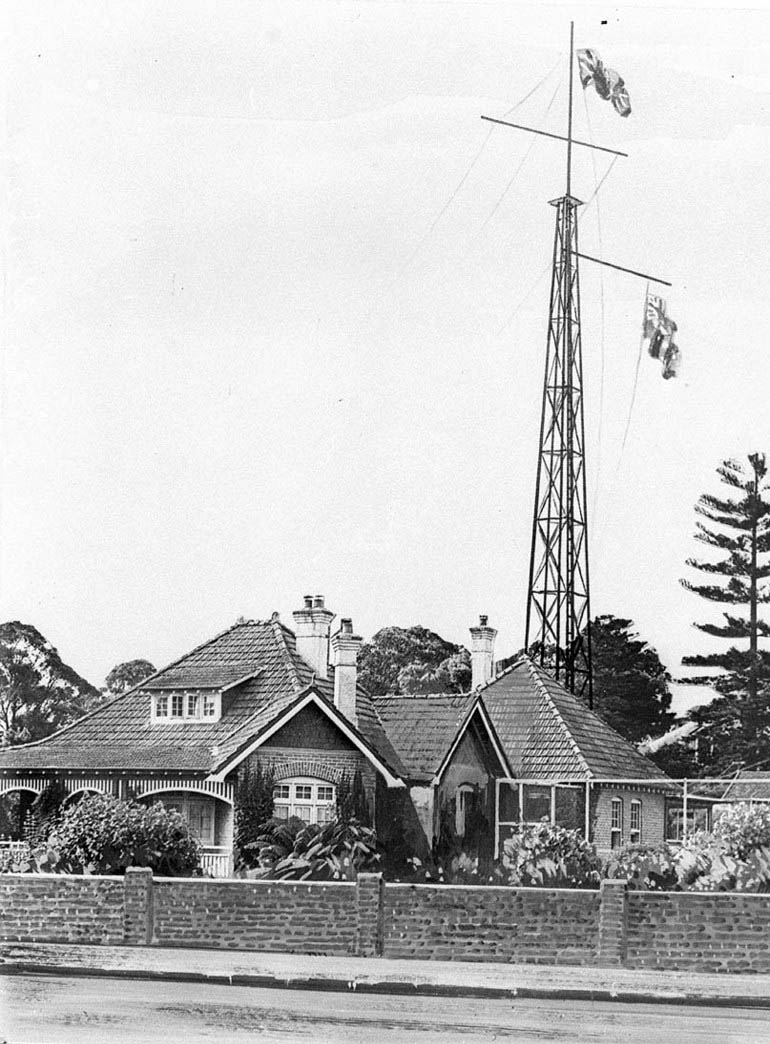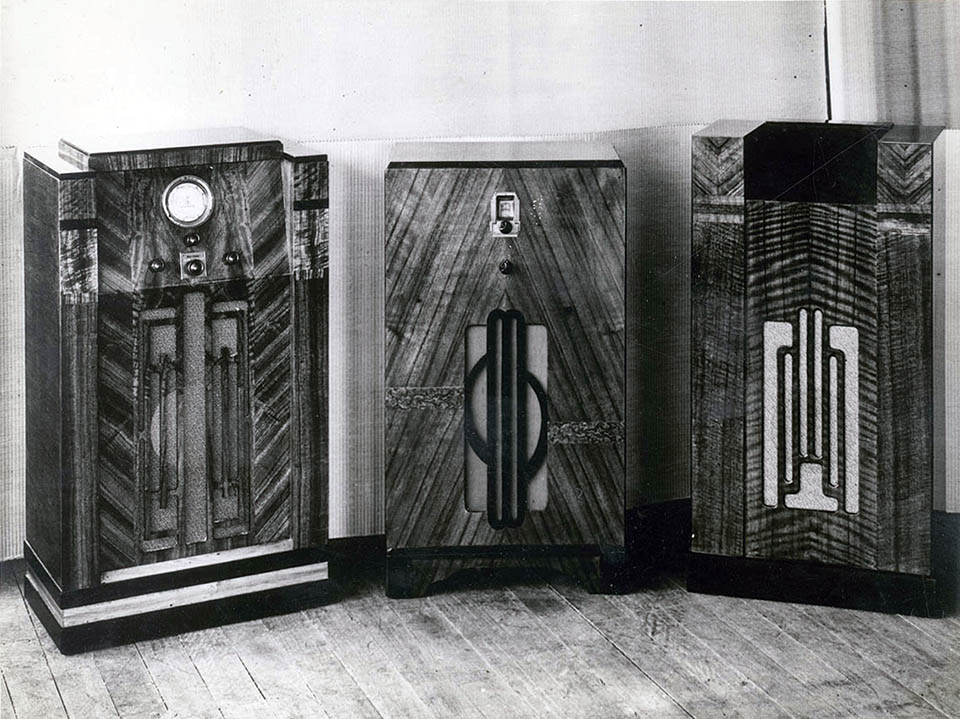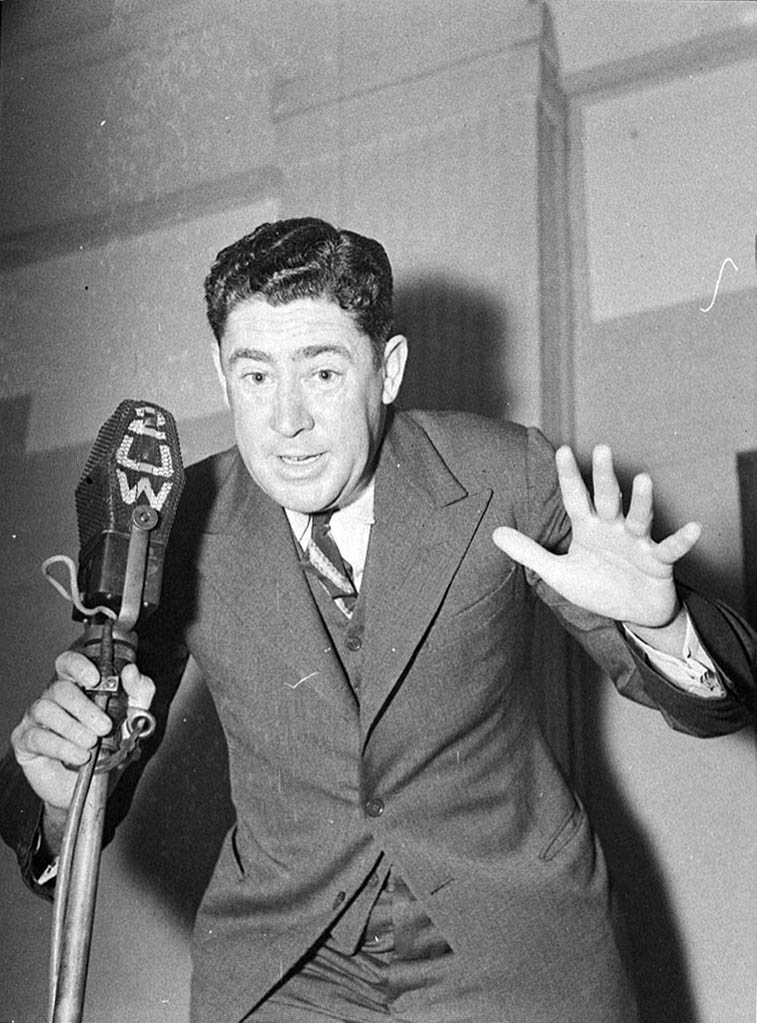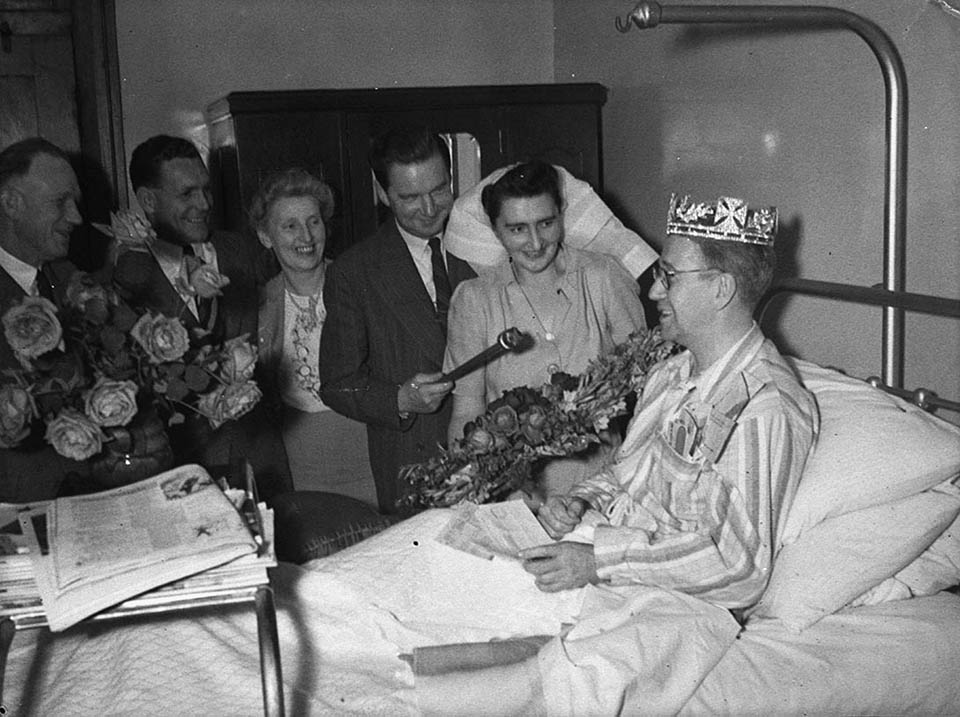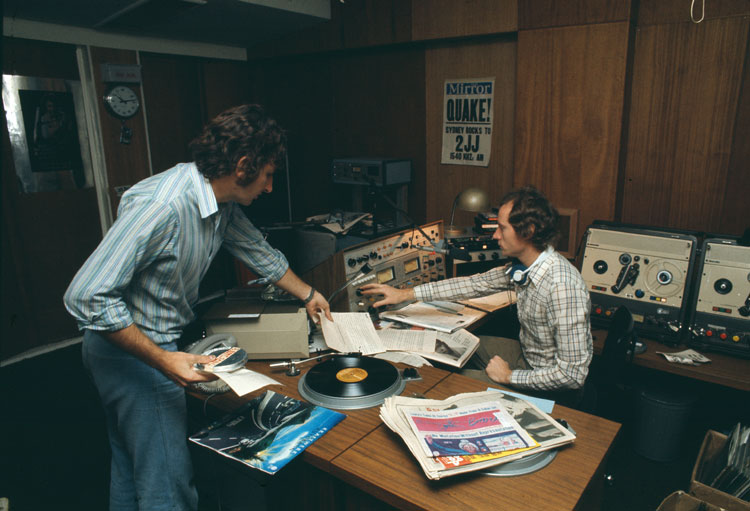The Dictionary of Sydney was archived in 2021.
Commercial radio
Citation
Persistent URL for this entry
To cite this entry in text
To cite this entry in a Wikipedia footnote citation
To cite this entry as a Wikipedia External link
Commercial radio
In the grounds of a house in Wahroonga once owned by Sir Ernest Fisk, the managing director of Amalgamated Wireless (Australasia) Ltd (AWA), lies one of Sydney's least-known monuments. [media]The inscription marks the transmission, on 22 September 1918, of the first direct wireless message from England to Australia. [1] In the years that followed, Australian radio broadcasting developed peripatetically, with various schemes, conferences and a royal commission to pass, in the quest for the basis of a sound regulatory regime.
[media]Amateur experimenters, almost missionary in their zeal, both transmitted and received messages. Enthusiasts, female as well as male, set up clubs across Sydney and beyond, as broadcasting was promoted as a force for family and imperial unity and a symbol of modernity. Manufacturers and retailers, eager to sell radio parts and sets, were quick to emerge. [media]By 1922, the Wireless Weekly had been established in Sydney, the same year in which the British Broadcasting Corporation was founded, and the United States experienced a remarkable radio boom. [2]
The first stations
[media]On 23 November 1923, 2SB (later 2BL), operating from a studio in the Smith's Weekly building in Phillip Street, became the first station in Australia to go to air. Soon afterwards came 2FC. Both were to become 'A'-class stations, meaning that they were maintained by revenue from listeners' subscriptions; in 1932 they were to help constitute a national broadcaster, the Australian Broadcasting Commission (ABC), whose head office was in Sydney. 'B'-class stations, which operated at a lower transmitter power and were reliant on advertising, and appeared very much as a residual category, began appearing in 1925. [3] [media]2UE commenced transmission from the Maroubra home of an electrical retailer, CV Stevenson. [4] By 1926, 2UW, 2KY (an organ of the Labor Council of NSW) and 2GB (an organ of the Theosophical Society) were also on air. Amateur experimenters and professional engineers interested in the two-way, point-to-point possibilities of radio telegraphy competed with, and were gradually vanquished by, retailing, manufacturing and other business interests, who saw greater commercial possibilities in providing regular content on a point-to-multipoint basis. [5]
Politics, religion and sport
Labor's victory under JT Lang in the 1925 New South Wales election was marked by the first broadcast (on 2KY) of an opening of parliament. While government regulations insisted that A-class stations show no political preference, on Sydney's B-class stations a propaganda battle raged. [media]Lang, whose 1927 policy speech was broadcast on 2KY, thought the barrage of Nationalist Party propaganda on 2GB was triggered by his government's provocative pledge to establish State radio, featuring a central metropolitan station with a chain of relays to the country. After losing office in 1927, Lang concentrated his energies on 2KY, to which federal and state Labor Party candidates had free access. [6]
As political and newspaper groups applied to the Commonwealth Postmaster-General's (PMG's) Department for B-class licences, religious interests also became more interested in radio's potential. After buying time on 2UE to publicise the Eucharistic Congress in 1928, and arranging for broadcasts to be relayed interstate, Monsignor James Meany established 2SM (named after his parish, St Mark's of Drummoyne) in 1931, for use by the Catholic archdiocese. The New South Wales Council of Churches followed suit, launching 2CH in 1932. But it was 'Dr Rumble's Question Box' on 2SM – heard at the same time on Sunday nights as the broadcasts of a trenchant Anglican, the Reverend TC Hammond, on 2CH – that emerged as the most famous religious program on Australian radio. [7]
Sport, too, was a mainstay of radio. [media]By 1928, 2KY was broadcasting descriptions of the boxing from Sydney Stadium in Rushcutters Bay each Wednesday evening, and from Leichhardt Stadium each Friday; the station's commentator, John Harper, became such a fixture at Sydney Stadium that he would not take his seat until he had been greeted by a round of applause. Sports callers and commentators were some of Sydney's biggest radio stars; reports of their exploits, broadcasting from outside fields, up trees and telegraph poles, and from vans and adjoining properties, only added to their allure. [8] However, there were internecine battles with sporting organisations, nervous that broadcasts would reduce attendances at events and worried about the escalating fees broadcasters were demanding for the 'right' to broadcast from their fixtures. [9]
Commercial radio
In the 1930s, B-class stations, gradually expanding both their broadcasting hours and their advertising revenue, agitated to be known as 'private' or 'commercial' stations. [10] Already, in 1930, they had organised themselves into the Federation of Australian Radio Broadcasters (now Commercial Radio Australia), with a paid secretariat in Sydney and Melbourne. [11] Some stations started forming alliances to share the expense of broadcasting major events and to create a larger market for advertisers. [12] In 1930, 2UW secured sponsorship of £3,000 from six city firms, and joined with 3DB in Melbourne to provide ball-by-ball coverage of the Australian cricket team's tour of England, a triumphant quest to regain the Ashes. [13] In 1932, a commercial relay covered the opening of the Sydney Harbour Bridge. [14] Three years later, the rapacious AWA's desire to purchase 2CH as a hub for relays to its country stations created an outcry. This resulted in the federal government limiting any one person or company to control of five stations throughout Australia. [15] These regulations helped both to restrict and to some extent stabilise radio ownership.
In 1935 the Institute of Radio Engineers of Australia proposed inviting Guglielmo Marconi to Sydney for Australia's sesquicentenary celebrations in 1938. Although Marconi died before he could take up the invitation, the World Radio Convention of 1938, featuring speakers such as John Logie Baird, was held at the University of Sydney. In his address, HP Brown, Director-General of the PMG's Department, noted that listeners had taken out over 1 million licences across Australia and that Australia's radio stations now broadcast for an average of 11½ hours per day. [16]
The hours were generally longer in the cities. [media]From 1935, 2UW broadcast continuously for 24 hours a day, probably becoming the first radio station in the British empire to do so. Its midnight-to-dawn program, designed to appeal to insomniacs and shift-workers, was promoted as a valuable service during emergencies. Commercial radio's emphasis on being of 'service' may not have been untouched by cynicism, with 2UW's studio manager telling a PMG inspector in 1936 that
he regarded his listeners as morons and treated them as such, hence the popularity of 2UW. [17]
Companion and solace
The industry presented radio as a companion offering solace and escape, particularly during the Great Depression. Radio stations and networks attempted to turn their personalities into the basis of popular social movements. [media]Some broadcasters and executives served multiple roles: 'Uncle Tom' (John Dunne) was lead announcer and studio manager of 2SM; 'Uncle Jack' (JM Prentice) was a news commentator and program manager of 2UW; and 'Uncle Lionel' (Lionel Lunn) was studio manager of 2UE.
Broadcasters often took over town halls and auditoriums, hosting 'Community Singing' concerts. 2GB's 'Uncle Frank' (Frank Grose) broadcast a 'Cheer-up' session on Saturday mornings, featuring music presented by Sydney's public school choirs. [18] His stablemate, 'Cousin Marjorie', represented radio in the 1931 'Miss Sydney' competition that raised funds for charity. [19] Some broadcasters took their listeners on excursions: 2CH's 'Hello Man' (AS Cochrane) and 'Fairy Godmother' (Margaret Herd), for instance, hosted a visit to the Jenolan Caves. [20]
Most stations had their own clubs, performing promotional and/or charitable functions. The most prominent was the 2GB Happiness Club, founded in 1929 by a former music teacher, Mrs WJ (Eunice) Stelzer, with the motto 'Others First'. Free to join, the club spawned dozens of branches and 'Younger Sets' across Sydney, with thousands of women members visiting the sick, collecting clothes for the needy, and staging afternoon teas, picnics, musicales and conversaziones. In 1940 the club established 'Eurobodalla' (meaning 'home between two waters') holiday homes for aged and needy couples, in Newport. [21]
The commercial radio sector's anxiety to promote its social utility stemmed in part from a desire to deter the Commonwealth government from becoming more involved in regulating the industry. During World War II, stations broadcast rallies for war loans, fund-raising concerts and appeals for recruits, and formed War Savings Certificate Groups. Leading radio personalities entertained troops in Australian military camps, and read out on air letters from servicemen and women. [22] In 1946 2UW joined with the Daily Telegraph to bring to Hyde Park 'Carols by Candlelight', which had been pioneered in Melbourne before the war to raise funds for charity and provided radio with a goodwill bonanza. [23]
Steering the shape and prosperity of commercial radio in the 1940s were the Australian arms of leading American advertising agencies. J Walter Thompson, handling the Lever Brothers account, introduced the Lux Radio Theatre and Australia 's Amateur Hour, which were recorded live in front of an audience in Sydney, and often went on tour. George Patterson established the Colgate-Palmolive Radio Unit, which in 1942 moved from Sydney to Melbourne. [24] The Macquarie Radio Network, with 2GB as its flagship and a range of member and 'co-operating' stations, formed a production arm, Artransa, to export programs to New Zealand and South Africa. [25]
Challenge and change
The advent of television in the second half of the 1950s meant that radio lost its place as the sole medium of electronic entertainment in the home, and introduced a new competitor for advertising revenue. In 1956, in a memo entitled 'Television Counter Measures', a Macquarie executive wrote of the need to intensify local advertising and an active interest in community affairs, promote microphone 'personalities', and encourage the sale of transistor and car radios. [26] Radio changed from being a family medium to a highly individualised one, with an average of one radio for every person over sixteen by 1962. [27] Broadcasters began targeting separate audiences, especially baby boomers, instead of the whole family. In 1958, an American-style 'Top 40' program was introduced to 2UE by Bob Rogers, and many other stations rushed to follow suit. In the 1920s Wireless Weekly had run photographs of listeners gathered around a cumbersome radio set at Manly beach; now, at last, the industry could stop fretting about the problem of 'summer radio' as the Top 40 format was heard drifting over beaches all weekend. [28]
News, weather and traffic reports improved. Many commercial stations embraced 'actuality' broadcasts, with reporters like Macquarie's Brian White (who in 1953 had become Australian commercial radio's first cadet journalist) using telephones for broadcasting descriptions of news events and on-the-spot interviews. [29] This technology also allowed for live, rather than delayed, traffic reports. In the late 1970s, 2GB set out to become Sydney radio's first 'helicopter eye in the sky' with the backing of a sponsor. [30]
Talkback arrives
The success of 'conversation' programs in the United States demonstrated to Australian radio executives that the telephone had other uses. In 1967 Australia's Broadcasting Program Standards were amended to allow the recording and rebroadcasting of telephone calls. [31] Until now, broadcasters like 2GB's Eric Baume, host of 'This I Believe', and John Pearce and 'Andrea' (Dorothy Jenner), had presented polemical monologues, conducted interviews and, perhaps, read out listeners' letters. From 1967 Sydney radio presenters such as Pearce and 2UE's Ormsby Wilkins could legally host 'dial-in' programs, and were joined by a new generation of talkback hosts, including a former disc jockey, John Laws. [32] In 1969 2GB launched 'Today with Brian White' on weekday afternoons, featuring the host 'dialling out' to key figures of the day, and helping to set the news agenda and educate housewives about public affairs. [33]
The rise of talkback radio ushered in a new generation of less authoritarian and more accessible religious broadcasters, such as 2SM's Father Jim McLaren, sometimes complemented by off-air counselling services. [34] Listener participation also became a key feature of a range of other radio programs, from sport to gardening, health to matchmaking.
FM and new broadcasting
If traditional religious programming was in decline due to commercial pressures and changing social mores, so was foreign-language broadcasting. [media]With postwar immigration, several Sydney stations had broadcast programs in languages such as Italian, Greek, Lebanese and Maltese (followed, according to government regulations, by English translations), the most popular of which was that of 'Mamma Lena' (Lena Gustin). But by the early 1970s, such programs were disappearing from the commercial airwaves as managements looked to appeal to general, rather than special interest, audiences. [35]
The Whitlam and Fraser governments shook up the Australian broadcasting landscape with a range of measures, opening the way for the long-overdue introduction of FM radio (beginning with a fine music community station, 2MBS-FM) and ethnic community radio. [media]In the mid-1970s, meanwhile, the ABC established a new youth station, 2JJ (later 2JJJ), and a classical music FM network. [36]
In 1978, after years of planning, Keith Graham and Mike Webb launched Sydney's first new commercial station in nearly half a century. Focusing on soft rock, with studios at Blacktown, 2WS set out to lure the growing listening and advertising markets of western Sydney. Its neighbour on the AM dial, 2SM, lost a legal case to prevent 2WS from going to air. [37] In 1980 two commercial FM stations, 2DAY-FM – partly owned by 2GB, Village Roadshow, Graham Kennedy, John Laws and Mike Willesee – and 2MMM-FM went to air in Sydney. [38] On commercial FM, playlists were more varied than the Top 40 format, the rate of rotation was lower and the number of advertisements was restricted. In 1984, 2MMM topped the ratings in Sydney. [39]
An increasingly competitive atmosphere prompted a range of radio stunts. When 2SM announced, in 1978, that it was going to 'take a jumbo under the Harbour Bridge' listeners crammed the Harbour expecting to see spectacular aerial acrobatics; instead what they saw was an elephant on a barge. 2UW, one of the first stations to produce stickers for the bumper bars of listeners' cars, [40] conducted promotions so vigorously that in 1980, after it was accused of pre-recording phoney winner calls, the Australian Broadcasting Tribunal imposed special conditions on its licence. [41] Possibly the biggest radio prize ever awarded was in 1984, when 2UE's 'Millionaire Mania' promised the winner $20,000 a year for up to 50 years. 2UE's executives were relieved, no doubt, when Premier Neville Wran drew from a barrel the name of an 'older lady'. [42]
With its superior sound quality and appeal to younger audiences, FM radio came to be associated with music and comedy, and AM radio with news and talk. AM stations such as 2GB and 2UE increasingly vied for success by signing up talkback hosts with strong, sometimes confected, opinions. 'The King' of Sydney radio – and of Australian commercial radio more generally – was John Laws, whose magnificent voice, along with his marriages, health, advertising deals, lunches with politicians, multi-million dollar contracts and threats to quit, kept the wider media industry fascinated, from the mid-1960s, when he first joined 2UE, until 2007, when he retired. [43] A stablemate at 2UE from the mid-1980s, and then a rival in the breakfast slot at 2GB, was Alan Jones, a former private school teacher and Australian Rugby Union coach, known for his conservative views, direct lobbying of politicians and populist appeal to 'Struggle Street'. [44]
Industry turmoil
In the late 1980s, legislative changes to ownership rules, a stock-market crash and a frenzy of interest in the media sector saw more than half of Australia's metropolitan commercial radio stations change hands, sometimes at ridiculous prices, and the entry of foreign players. [45] Licence auctions allowed the Adelaide-based Austereo, under managing director Paul Thompson, to form the first national FM network, of which 2DAY-FM was part. [46]
In 1993-94 2UW and 2WS were allowed to switch to the FM band and become MIX-FM and WS-FM. [47] These two stations formed part of the Australian Radio Network, part owned by the American broadcasting behemoth, Clear Channel. After the Triple M group merged with Austereo, Thompson was not idle for long. He teamed up with the British Daily Mail Group (DMG) to purchase regional Australian stations. [48] When metropolitan licences became available, DMG pounced, paying a record $155 million at auction in 2001 for a new Sydney FM licence. Under the slogan 'Sounds Different', DMG's Nova 96.9 introduced a mixture of musical genres, promised listeners never to play more than two advertisements in a row, and poached Merrick and Rosso (Merrick Watts and Tim Ross) from 2JJJ for the crucial breakfast slot. [49] Less immediately successful was DMG's Vega 95.3, whose 'FM talk' experiment, designed to appeal to baby boomers, was abandoned in 2006, a year after the station's launch. [50]
The safest source of advertising revenue for FM stations came to be seen as 25- to 39-year-olds. Station managements competed for this audience through on-air personalities rather than on the basis of innovative music content. In both the FM and AM radio markets, conservative programming decisions privileged music that was already known; [51] this affected the market for new Australian music.
Celebrity and scandal
Meanwhile, on the AM band, controversy was never far away. In 1999 ABC television revealed that 2UE's John Laws had made a lucrative deal with the Australian Bankers' Association to cease criticising banks on air. The Australian Broadcasting Authority launched an investigation into whether it was 'appropriate in a democracy for a corporation to seek to purchase covert rather than overt dissemination of its opinions'. The inquiry found that the failures of Laws and Alan Jones to disclose commercial agreements had led to numerous breaches of the commercial radio Code of Practice, and therefore that 2UE had failed to comply with the conditions of its licence. New conditions on 2UE's licence required the disclosure of interests and the differentiation of advertising from program material. Laws turned the disclosure of the sponsorships he was 'proud' to have into something of an advertisement, replete with cowbell sound effects. Further allegations of 'cash for comment' involving Laws and Jones in 2002 exposed more significant flaws in the regulatory framework. [52]
In addition to figuring in enquiries conducted by the regulators, Sydney radio presenters offered constant fodder for the gossip pages. The competition between the stars of talkback, in particular, was invariably fierce and occasionally farcical. Many presenters had their own business managers, such as John Fordham (for Laws) and Harry M Miller (for Jones); some had their own management or production companies, including Kyle Sandilands's King Kyle and Merrick and Rosso's Smoke and Mirrors. [53] Several presenters, such as Derryn Hinch, Andrew Denton, Sonia Kruger, Kate Ritchie and 'Jackie O' (Jackie O'Neill), moved between radio and television.
Beyond local communities
From the 1980s, satellite technology enabled the transmission of whole programs (including the John Laws show), across the country, with time calls, local weather and advertising sent to stations individually to create a 'local' feel. [54] During his time on 2DAY's breakfast show with Wendy Harmer, Peter Moon actually lived in Melbourne, something kept secret for years. [55] In 2001 Howard Sattler, formerly a top-rating presenter on 6PR, began broadcasting the morning program on 2SM from his home in Perth. With its miniscule ratings, 2SM's value now lay in serving as a hub for the 30 regional stations also owned by the reclusive Bill Caralis. [56] Digital technology made the pre-recording of music content easier and more sophisticated. [57]
In 2000, a syndicate paid $10 million for a licence to serve the Campbelltown region; C91.3 went to air in August 2001. [58] A few months later, WS-FM became just another FM station when it moved from western Sydney to North Ryde. [59] On Christmas Day 2001, it proved unwilling or unable to interrupt its classic hits to broadcast information about the bushfires that threatened Sydney. [60] The contrast with the earlier years of Australian radio, when stations attempted to 'service' the local community, could not have been greater.
Commercial radio stations in Sydney, as in other metropolitan markets, now face the challenges of remaining attractive to audiences and advertisers, as portable audio devices such as MP3 players grow in popularity. But there may be opportunities, too, as radio stations look to develop their podcasting and online services and convert to digital transmission.
Notes
[1] Ian K Mackay, Broadcasting in Australia, Melbourne University Press, Melbourne, 1957, p 17
[2] B Griffen-Foley, 'The birth of a hybrid: The shaping of the Australian radio industry', The Radio Journal, vol 2, no 3, 2004, pp 154–5
[3] B Griffen-Foley, 'The birth of a hybrid: The shaping of the Australian radio industry', The Radio Journal, vol 2, no 3, 2004, pp 157-9
[4] Sun, 15 February 1955
[5] See Michael S Counihan, The Construction of Australian Broadcasting: Aspects of Australian Radio in the 1920s, MA thesis, Department of History, Monash University, 1981
[6] Murray Goot, 'Radio LANG' in Heather Radi and Peter Spearritt (eds), Jack Lang, Hale & Iremonger, Sydney, 1977, pp 121–34; Ian Ward, 'The early use of radio for political communication in Australia and Canada: John Henry Austral, Mr Sage and the Man from Mars', Australian Journal of Politics and History, vol 45, no 3, p 323; Wireless Weekly, 17 June 1927, p 2, 24 June 1927, p 2
[7] B Griffen-Foley, 'Radio ministries: Religion on Australian commercial radio from the 1920s to the 1960s', Journal of Religious History, vol 32, no 1, March 2008, pp 33–47
[8] B Griffen-Foley, 'Sporting chances: Sport on Australian commercial radio from the 1920s to the 1950s', Sporting Traditions, vol 23, no 1, 2006, pp 37–51
[9] B Griffen-Foley, 'Sporting chances: Sport on Australian commercial radio from the 1920s to the 1950s', Sporting Traditions, vol 23, no 1, 2006, pp 37–51
[10] Broadcasting Business, 25 November 1937, p 2
[11] Wireless Weekly, 21 November 1930, p 9
[12] B Griffen-Foley, 'The birth of a hybrid: The shaping of the Australian radio industry', The Radio Journal, vol 2, no 3, 2004, pp 160–1
[13] B Griffen-Foley, 'Sporting chances: Sport on Australian commercial radio from the 1920s to the 1950s', Sporting Traditions, vol 23, no 1, 2006, pp 38–9
[14] Wireless Weekly, 11 March 1932, pp 18-19
[15] Broadcasting Business, 7 November 1935, pp 6–7, 14 November 1935, pp 1–2, 4–6
[16] Broadcasting Business, 7 April 1938, pp 8–9
[17] B Griffen-Foley, 'Midnight to dawn programs on Australian commercial radio', Journal of Radio Studies, vol 11, no 2, Winter 2004, pp 242–4
[18] State Library of NSW, Mitchell Library, MSS 3261, Frank Grose Papers, Box 1
[19] Wireless Weekly, 25 September 1931, p 3
[20] Wireless Weekly, 2 September 1932, p 11
[21] R Grahame, 'Eunice Minnie Stelzer (1880–1962)', Australian Dictionary of Biography, vol 16, Melbourne University Press, Melbourne, 2002, pp 300–1; See also B Griffen-Foley, 'Modernity, intimacy and early Australian commercial radio', in Talking and Listening in the Age of Modernity: Essays on the History of Sound, eds Joy Damousi and Desley Deacon, ANU e-Press, 2007, pp 127–8, http://epress.anu.edu.au/tal_citation.html
[22] Broadcasting Business, 23 May 1940, p 3, 8 May 1941, p 3
[23] State Library of NSW, Mitchell Library MSS 3261, Frank Grose Papers, Box 1, Minutes of meetings of 2GB Community Chest, 27 September 1946
[24] J Potts, Radio in Australia, New South Wales University Press, Sydney, 1989, pp 66–80
[25] Ian K Mackay, Broadcasting in Australia, Melbourne University Press, Melbourne, 1957, p 154
[26] John Fairfax Archives: Box 20027/24, memo from SRI Clark to 2GB board, 11 July 1956
[27] Sydney Morning Herald, 16 July 1962
[28] Wireless Weekly, 21 December 1923, p 16; G Turner, 'Who killed the radio star? The death of teen radio in Australia', in T Bennett et al, Rock and Popular Music: Politics, Policies, Institutions, Routledge, London, 1993, p 143
[29] Australian Broadcasting Control Board Annual Report, 1958, pp 18–19; Age, 23 May 1990, p 18
[30] John Fairfax Archives: Box 20027/25, Bundle: Board Figures 1955 [sic], letter from Hugh Elliot to AH McLachlan, 24 October 1950; Box 20027/9; File: Macquarie Broadcasting General 1977–78, letter from Ron Hurst to 2GB board, 30 May 1978
[31] L Gould, 'Talk, telephone and the radio: The introduction of “talk-back” radio in Australia', Making a Difference: Australian and New Zealand Communication Association conference, University of Sydney, 2004, http://conferences.arts.usyd.edu.au
[32] B Griffen-Foley, 'Before the Parrot: The “news commentator” on Australian commercial radio', Australian Media Traditions: Politics, Media, History Conference, Canberra, 2005, http://www.canberra.edu.au/faculties/comm-international/amt/LevelTwo/AMT2005refpapers.htm
[33] Sydney Morning Herald, 23 May 1990, p 9
[34] B Griffen-Foley, 'Radio ministries: Religion on Australian commercial radio from the 1920s to the 1960s', Journal of Religious History, vol 32, no 1, March 2008, pp 53–4
[35] B Griffen-Foley, 'From the Murrumbidgee to Mamma Lena: Foreign-language broadcasting on Australian commercial radio, Part 2', Journal of Australian Studies, no 90, 2007, pp 77–87, 190–92
[36] B Griffen-Foley, 'Radio', in S Cunningham and G Turner (eds), The Media and Communications in Australia, 2nd edition, Allen & Unwin, Sydney, 2006, p 138
[37] Sun-Herald, 5 November 1978; Daily Mirror, 10 September 1979, p 13
[38] Sunday Telegraph, 13 July 1980, p 15; G Blundell, King: The Life and Comedy of Graham Kennedy, Macmillan, Sydney, 2003, p 350
[39] Sun-Herald, 25 November 1984
[40] Sydney Morning Herald, 24 May 1982
[41] Sun-Herald, 2 October 1983
[42] Sydney Morning Herald, 14 April 1986
[43] Timothy Hall, John Laws: Life By Misadventure, Angus & Robertson, Sydney, 1985
[44] Chris Master, Jonestown: The Power and the Myth of Alan Jones, Allen & Unwin, Sydney, 2006
[45] B Griffen-Foley, 'Radio', in S Cunningham and G Turner (eds), The Media and Communications in Australia, 2nd edition, Allen & Unwin, Sydney, 2006, pp 140–1
[46] Advertiser, 5 August 1989, Magazine section, p 3
[47] Sydney Morning Herald, 2 June 1993, 30 January 1995
[48] Australian, 25 April 2002, Media section, p 6
[49] Sydney Morning Herald, 17 November 2003, The Guide, p 4
[50] Australian, 1 June 2006, p 17
[51] G Turner, 'Who killed the radio star? The death of teen radio in Australia', in T Bennett et al, Rock and Popular Music: Politics, Policies, Institutions, Routledge, London, 1993
[52] Australian Broadcasting Authority, Commercial Radio Inquiry: Final Report of the Australian Broadcasting Authority, the authority, Sydney, 2000; Rob Johnson, Cash for Comment: The Seduction of Journo Culture, Pluto Press, Sydney, 2000
[53] Daily Telegraph, 17 February 2007, p 23, 28 May 2008, p 25
[54] B Griffen-Foley, 'Radio', in S Cunningham and G Turner (eds), The Media and Communications in Australia, 2nd edition, Allen & Unwin, Sydney, 2006, p 140
[55] Sydney Morning Herald, 31 July 2006, The Guide, p 5
[56] Australian, 10 February 2000, Media section, p 12, 27 July 2002, Media section, p 7
[57] Sydney Morning Herald, 31 July 2006, The Guide, p 5
[58] Australian Communications and Media Authority Annual Report, 2001, p 61; Sydney Morning Herald, 20 August 2001, The Guide, p 2
[59] Sydney Morning Herald, 30 July 2001, The Guide, p 3
[60] Australian, 24 January 2002, Media section, p 4
.


